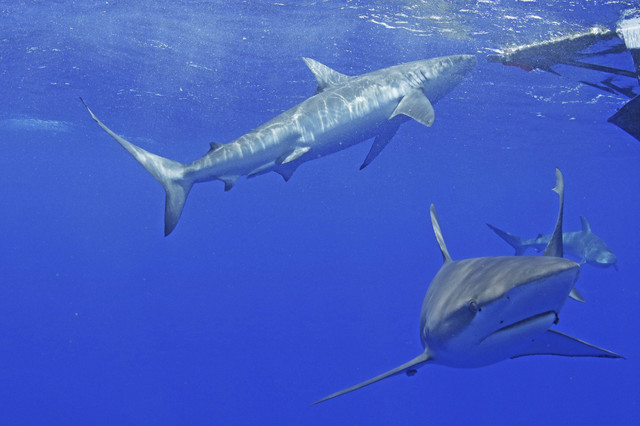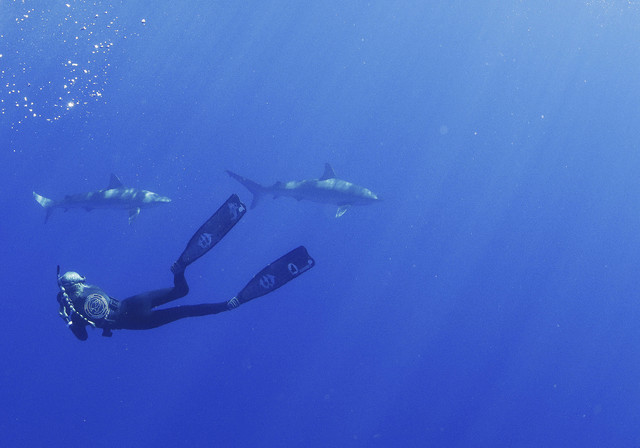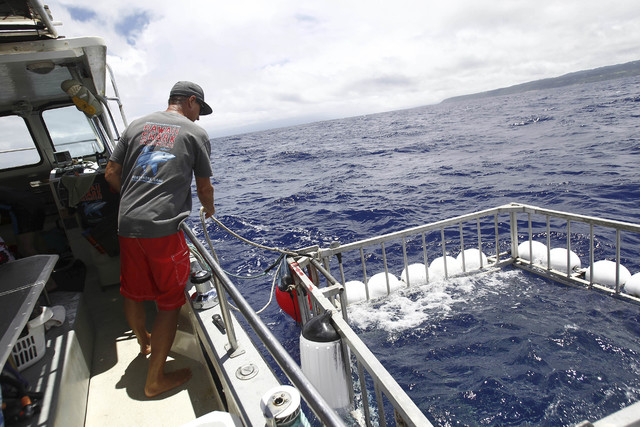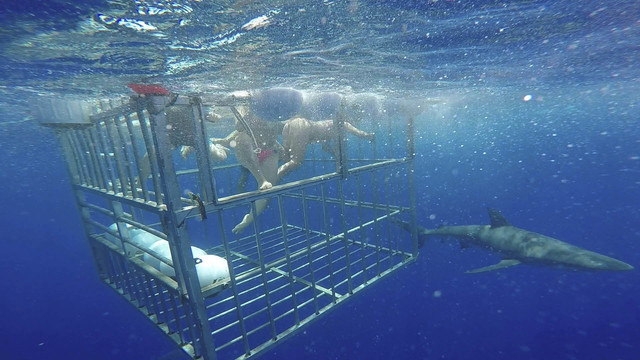HONOLULU — On a calm, early mid-July morning, beneath the surface of the cobalt-blue Hawaiian sea 3 miles from shore, a silent communication was taking place between two species of predators. An 8-foot-long male Galapagos shark slowly circled four swimmers, who kept turning to maintain eye contact with him, as they had been instructed by their guide, Ocean Ramsey.
“When you turn your head and make eye contact, you’re communicating to the shark that you’re a predator, not prey,” Ramsey, co-founder of the company One Ocean Diving, had explained on the boat ride out to the dive site, a place where sharks “naturally aggregate” in waters 300 feet deep above an underwater ledge.
There, where the land slopes into the oceanic depths, she said, sharks are drawn by strong, converging currents where cooler water upwells and nutrients tend to be more abundant, attracting fish, the Honolulu Star-Advertiser reported on Sunday.
Sharks are having a moment, and most of the media spotlight has not been positive.
World champion surfer Mick Fanning recently had a live, on-camera tussle with a great white shark that bumped him during the J-Bay Open surf contest in Jeffreys Bay, South Africa. The Australian survived physically intact but badly shaken.
In April a snorkeler off Maui died after being bitten by a tiger shark, and by the time the Discovery Channel’s wildly popular “Shark Week” programming launched July 5, it had almost been upstaged by the media outcry over eight real-life shark attacks on North Carolina swimmers, two of whom lost an arm, and 11 attacks in Florida.
Although the string of incidents in North Carolina is unusual for that state, there’s been no increase in shark attacks nationwide compared with last year, according to George H. Burgess, director of the Florida Program for Shark Research and Web editor of the International Shark Attack File.
Despite the widely reported fatalities, maimings and bites, humans seem more fascinated by sharks and interested in encountering the fearsome creatures than ever. Witness actor Zac Efron’s dive in June with a tiger shark off Haleiwa, Oahu, which got wide exposure when he shared video and photos of what he called an “epic” experience.
Shark ecotourism, which generates $314 million a year worldwide, is expected to more than double over the next 20 years, according to a 2013 study by researchers at the University of British Columbia, University of Hawaii and the Universidad Autonoma de Baja California Sur in Mexico.
What’s the allure? Based on recent interviews with participants in cage and free-swimming shark viewing tours in Haleiwa, Oahu, people are motivated by thrill-seeking, curiosity and a desire to overcome their fear.
“I’ve always been so scared of sharks, but once I saw how beautiful they are in the water, now I’m in love with them,” said Natasha Brolick, 26, visiting from Melbourne, Australia, after viewing Galapagos sharks from an underwater cage during a July 16 dive with Hawaii Shark Encounters of Haleiwa, Oahu.
The cage tours frequent a site 3 miles off Haleiwa where a crab- fishing fleet used to set its baited traps 50 years ago. Although Hawaii Shark Encounters does not chum the water (an illegal practice since 2009), sharks in the area continue to associate engine noise with food.
During the ride out on the dive boat Kainani, Capt. Richard Whyte and mate Darrin Whittaker gave safety briefings, pointing out the two fire extinguishers “in case we catch on fire again” and regaling the 13 passengers with facts and statistics, noting that the first sharks appeared on Earth 450 million years ago.
On deck before the dive, the crew got serious, asking everyone to keep their eyes on the captain, not the sharks circling the boat, to learn the right and wrong way to get in the metal cage and comport oneself while inside. Conditions were rough, with wind and swells, and divers were advised to grip an interior bar for stability. Whyte and Whittaker made sure everyone’s masks and fins fit correctly.
In a cage attached to the boat, a group of six viewers was quickly surrounded by 12 to 15 large Galapagos sharks. The animals circled tightly and swam much closer to the humans than had the sharks on the cage-free dive, coming within a foot of the plexiglass window and steel bars.
In the bright midmorning light you could see the little yellow-blue pilot fish swimming in front of the sharks’ pointed snouts, remoras clinging to their sides and copepod parasites in their eyes and gills. One shark opened its mouth slightly as it approached the cage. Another took a test bite of a GoPro camera on a selfie stick protruding through the bars.
“The sharks feel safer when you’re in a cage,” said Hawaii Shark Encounters owner Steve Jordan with a smile. “The more people learn about sharks, the better off the sharks are,” he said, adding that after a cage dive, some of his clients sign up for a cage-free dive with One Ocean.
Certainly people are safer in a cage, but there has been controversy as to whether shark tours pose an increased risk of attack to swimmers closer to shore. In a 2009 study, co-author Carl Meyer, a researcher at the Hawaii Institute of Marine Biology, reported that cage diving off Haleiwa, Oahu “had no visible effects on the movements of sharks in the area.”
In other words, the sharks did not follow the boats back to shore — a concern that had been voiced by residents of the area.
So long as sharks are simply watched and not fed, shark tours aren’t detrimental to the animals and might benefit them by inspiring conservation efforts, Meyer told the Star-Advertiser. Cage-free shark viewing, however, could be detrimental — to humans, he added.
It was the third cage-free dive for Ethan Wang, 25, who lives in Manoa. When he saw sharks while out surfing, he used to panic and paddle straight in. Now, he said, he knows not to turn his back and splash away, but to face the shark and keep calm.
“I would highly recommend this dive to any active water person,” Wang said.













